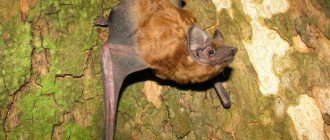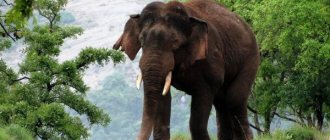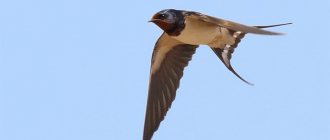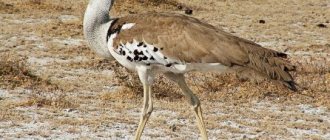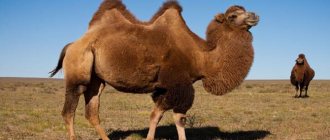Many, many centuries ago, the Asiatic lion (also called the Indian lion) lived over a vast territory - from northeastern India to modern Italy, as well as in Iran, the Arabian Peninsula, northern Africa, and Greece. It was these animals that entered into battles with gladiators in the arenas of the amphitheaters of Rome. Hunting predators was considered a very prestigious activity, although dangerous. But a different time has come. People armed themselves with more advanced weapons, and lions ceased to interest them.
Where does the Asiatic lion live now?
Currently, this ferocious beast can be seen only in one corner of the globe (in the natural environment, not counting zoos). The Asiatic lion lives in India, in the state of Gujarat. The area of the reserve is small - only 1,400 square kilometers.
In 2011, there were four hundred and eleven individuals in this area. This is fifty-two lions more than in 2005, which is good news.
Interesting facts about the lion:
- The lion is an old and popular heraldic symbol, and is associated with royalty and nobility.
- The maximum weight recorded for a male lion was 370 kg. The maximum body length of this predator was 3.6 m.
- Leos are often called the “Kings of Beasts”. In the folklore and mythology of the inhabitants of Africa, this predator personified the highest divine power, power and greatness, power. In the traditions of Europe, it was a symbol of the power of the sun and fire, courage, valor, pride, nobility, justice, and triumph. The image of a lioness was more often associated with motherhood, mother goddesses, and voluptuousness.
Appearance of a predator
A very formidable beast is the Asiatic lion. Describing it will not convey the power and strength that is hidden in it. This is truly a powerful and beautiful animal. Interestingly, the Asiatic lion is slightly smaller than the African lion. Their manes are also different. The “Africans” have it more magnificent. The weight of males reaches one hundred sixty to one hundred ninety kilograms. Females are slightly smaller, their body weight, as a rule, does not exceed one hundred and twenty kilograms.
But the height at the withers reaches one hundred and five centimeters. Just imagine: the body length ranges from 2.2 to 2.4 meters. The maximum value is 2.92 meters. Color ranges from brown-red to gray-sand. The Asiatic lion (photos are given in the article), as we see, is a very large and strong animal.
Dictator
Saddam Hussein sat on the podium with a cigar in his mouth and grinned. Opposite him, huddled in chairs, sat two hundred people - the political elite of the country, the leaders of the Baath Party who had passed through the fire of battle. Saddam was in no hurry—he slowly and with relish read out the list of names of everyone present. “Ahmed... Is he a conspirator? No. And Ishmael? Yes!" — those whom Saddam called traitors were taken straight out of the hall by his henchmen.
The new dictator ordered to deal with them “with the edge of the sword” - of the 68 detainees, 22 were sentenced to execution. Those who were pardoned were given rifles - they shot their “guilty” comrades. During the days of Hussein's rise to power, reprisals against Baathists disloyal to him began throughout the country.
These killings cemented Hussein's power. There was no talk of any Baathism or Arab nationalism: the country followed the path of Saddamism. The new dictator began to consider himself equal to the great generals and emperors of the past: he compared himself with the Babylonian king Nebuchadnezzar or the military leader Saladin. However, the very first “commanderial” attempt turned into a terrible failure: in 1980, Iraqi troops invaded Iran, which had just experienced the Islamic revolution.
There was an old territorial dispute between the countries, Hussein was afraid of a Shiite revolution in his country, but one of the main reasons was Saddam’s desire to organize a small, victorious war. Iranian ayatollahs sent out a cry throughout the country, and for the newborn Islamic Republic, the war with Iraq became a real patriotic war.
In the fight against the Iranian threat, Hussein asked for help from the West: the Americans supplied Baghdad with dual-use goods (for example, computers) worth half a million dollars. Computers came in handy when Saddam decided to try to make nuclear weapons: in the early 1980s, a nuclear reactor was built in Iraq with the help of French specialists. The following passage appeared in the Al-Thawra newspaper: “The people of Iran should not be afraid of the Iraqi nuclear reactor. It will not be used against Iran, but against the Zionist enemy."
The “Zionist enemy” did not wait: on June 7, 1981, Israeli planes bombed a reactor built by the French. Experts argued that it would take decades to produce nuclear fuel for a bomb, but the Israelis decided to play it safe.
Hussein, having lost any chance of acquiring nuclear weapons, decided to obtain chemical and biological weapons. This is where supplies from the Americans came in handy: those samples of anthrax, West Nile fever and botulism that Iraq requested for medical research and vaccine production were used to develop biological weapons. The production of “chemistry” also turned out to be successful: the first bombs with mustard gas (mustard gas) fell on the heads of Iranian soldiers already in 1983.
This did not help: in eight years of a terrible war, almost a million people died, but the borders of the countries did not even move. It was only thanks to Soviet aid that Saddam had not been defeated, but Iraq lay in ruins: the once wealthy regional “energy superpower” had accumulated debt and was bursting at the seams. Dissatisfied residents of the country staged demonstrations, and conspiracies were brewing even in Hussein's family. He tried to punish the Kurds who were disloyal to him - ammunition with mustard gas was dropped on their houses, troops carried out cleansing operations, and real genocide was going on in the country. It is estimated that, on Saddam's orders, Iraqi authorities killed about a hundred thousand Kurds and destroyed their homes.
American senators tried to impose sanctions against Iraq, but the Reagan administration did not allow this: Baghdad was buying American food, and the White House believed that Iraq, being an enemy of Iran, automatically became a friend of the United States. The turning point came in 1990.
American soldier guarding prisoners
Photo: Jacques Langevin/Sygma/Getty Images
Hussein asked his Arab neighbors to write off his debts, but they did not listen to him. Then he accused neighboring Kuwait of stealing Iraqi oil and sent troops there. “Dear citizens. History has proven that Kuwait is part of Iraq. We call on all Iraqis to follow the heroic leader Saddam Hussein,” the Iraqi dictator's spokesman said on national television.
He hoped that the Americans would support him this time too, but in vain: Washington was ready to help in the fight against Shiite Iran, but did not want to get involved in Arab squabbles, and therefore took a sharply anti-Iraqi position. Even the USSR, guided by perestroika dogmas, opposed Saddam’s intentions - Iraq suffered a humiliating defeat, losing all its stockpiles of chemical and bacteriological weapons. Coalition forces did not overthrow Saddam: US President George W. Bush spoke in front of cameras and called on the Iraqi people to overthrow the dictator on their own.
The Americans, having seen the light, finally imposed sanctions. The UN Security Council also adopted resolution 661, establishing a trade embargo against Iraq. The era of sanctions has arrived. The country lacked food, food cards were introduced. Foreign exchange reserves quickly depleted, the authorities turned on the printing press and accelerated inflation. All the “conquests of the Baathists” were forgotten - no one thought about women’s education or infrastructure. Due to the lack of spare parts, broken machines and machines stood idle. Saddam was in style at this time: since the end of the war, he has spent two billion dollars on new palaces and a billion on supporting the Palestinian struggle against Israel.
A Shiite uprising broke out in the country, which Hussein ruthlessly suppressed, flooding the country with blood. He cultivated the image of a winner - he withstood the crusading coalition and did not surrender the country to Christians. Statues and portraits of Saddam appeared throughout Iraq. Two referendums were held, in which the dictator received first 99.6 and then 100 percent of the support of the population. During these years, he made a sharp turn towards religiosity, and the inscription “Allahu Akbar” appeared on the country’s flag. It was then that the legendary “Bloody Koran” was created, writing which Hussein spent 27 liters of his own blood.
Asiatic lion behavior
The Asiatic lion is a social animal. Predators live in family groups called prides. However, Asian flocks are small. This is explained by the fact that in Asia the prey is much smaller in size. This means that only two lionesses can hunt an ungulate, not six. Males only guard the territory and reproduce. These are their responsibilities. Only lionesses get food. So the males settled in pretty well.
Asian prides number 8-12 animals, and African prides can have up to thirty cats (these are females, males and cubs). There can be no more than two males in a group; they are mostly brothers. One of them always dominates, both in battle with the enemy and when choosing a female. The pride is based on female individuals who are related and, most interestingly, friendly. The group continues to exist for several years.
The pride lives in a certain territory, which it reserves for itself. Its size depends on the amount of prey, the size of the group and can cover up to four hundred square kilometers.
Males, having reached two or three years of age, leave the family. They either remain alone, or unite with their peers and wander around the pride, waiting for the moment when the leader weakens, then they will capture the group and hold it for a couple of years. It is easier for several males to defend their pride than for one lion.
Here, their own, often cruel laws reign... Having captured the group, the first thing the male does is destroy the lion cubs. Lionesses usually cannot influence the situation. Only cubs over one year old have a chance to survive. After the death of the offspring, the female calms down after a couple of weeks and then gives birth to new cubs for the leader. This behavior of lions gives them the opportunity to have their own offspring. Since leaders change every three to four years, if they left other people’s cubs to live, they simply would not have time to raise their own.
Shadow of the Third Reich
The glow of the Second World War was flaring up in the world, Hitler's tanks were ironing Europe with might and main - in this difficult time, Britain needed guarantees of the loyalty of the Iraq they had created. The head of the country at this time was Faisal II, the grandson of Faisal I. The three-year-old boy could not rule himself, and he was appointed a regent, who generally satisfied the British.
In 1941, the military, dissatisfied with the dominance of London, took their step. They created their own government, appointed Rashid Ali as prime minister, expelled the hated regent and proclaimed a course towards rapprochement with the Third Reich. The British could not stand such a slap in the face - they began to transfer soldiers from India, and on May 2, just a month after the coup, His Majesty’s troops invaded Iraq. Religious authorities declared jihad on London.
The British, however, enjoyed success: it was noted personally by Winston Churchill. “Your brilliant and courageous actions have practically restored the situation. We are following your wonderful campaign. We will send all the necessary help. Continue in the same spirit!" - the Prime Minister wrote to the group's commander just five days after the invasion.
By that point, the RAF had destroyed almost all of the Iraqi aircraft and victory looked assured. But the German Nazis were preparing to play their role. German Foreign Minister Joachim von Ribbentrop persuaded head of state Adolf Hitler to intervene: the Fuhrer issued Decree No. 30 on support for Arab nationalists, and on May 6, Luftwaffe Colonel Werner Junck received orders to transfer planes to the Middle East.
British soldiers fire a 60-pounder cannon in Mesopotamia
Photo: Public Domain/Wikimedia
France, which they occupied, provided assistance to the Nazis: German pilots used its bases in Syria and regularly attacked British ground units. All 30 Yunk aircraft were painted in the colors of the Iraqi aviation. Major Axel von Blomberg flew to Baghdad to coordinate the actions of the Iraqi troops and the Luftwaffe, but his plane was fired upon by the Iraqis themselves. Already on the ground it became clear that the German commander was dead.
At that time, under the provisions of the Molotov-Ribbentrop Pact, Germany and the USSR were de facto allies and Moscow recognized the Nazi-backed Iraqi government. Meanwhile, Vichy France, at the request of Germany, transferred to Iraq 15.5 thousand rifles, 6 million cartridges, 200 machine guns and 900 machine gun belts, as well as four 75-mm guns with 10 thousand shells. Subsequently, 30 thousand grenades, eight 155-mm guns with 6 thousand shells and 32 trucks were delivered through Turkey.
The British fought skillfully, and Goering's Falcons were unable to turn the tide of the war - even Italian planes sent by Hitler's ally, dictator Benito Mussolini, did not help. By the end of May, Baghdad was taken - Rashid Ali, the Grand Mufti who proclaimed jihad, and many other members of the government fled first to Persia and then to Germany. The British returned their regent to Baghdad, and the situation returned to normal. Iraq again found itself under British rule, and the troops transferred there went to Persia to occupy it together with the Red Army. The Germans also left - leaving, for example, two broken Heinkel He 111 bombers right in ancient Palmyra.
Number of Asiatic lions
As already mentioned, the Asiatic lion is distributed in Eurasia, in the northeast of India, in the Gir forests. After mass extermination in the 19th century. their numbers dropped noticeably; in 1884, graceful beauties were found only in the west of Hindustan. After 14 years, the Nawab of Junagadh declared their protection.
But even today, despite all attempts to preserve the species, the population of the Asiatic lion is very low, which causes natural concern. At the end of the twentieth century, they even opened a special program for breeding animals in the forests of North America. An important factor is also the preservation of the purity (genetic) of this species. This means that Asian and African brothers cannot be crossed, since the Asiatic lion is already less common in nature. He may simply “get lost” among the inhabitants of the African savannah.
Red Book
The lion was listed in the Red Book at the beginning of the 20th century, after it was massively exterminated in the last century. Since the animal does not live anywhere except the above-mentioned reserve, the Gir forests are under special control of animal rights activists.
They also ensure that Indian and African lions do not mix. This is justified by the fact that the genes of their Asian counterparts are recessive, so mixing them with the inhabitants of the hot continent will lead to the slow destruction of the Eurasian population.
Girsky Reserve
The Girsky Nature Reserve has made progress in increasing the lion population. The leadership of the state in which the reserve is located does not yet plan to transfer a single animal to the menageries of other states. Since this animal is unique, the reserve has various privileges. And if lions become commonplace in other places, the situation could change radically.
In particular, you can remain without government support. However, in any case, the number of lions is gradually increasing, and therefore the time will certainly come when some of them will leave the territory of the protected area and move to new territories.
National Socialism in Arabic
Saddam Hussein, the future dictator, was helped through the turbulent 1960s by his friendship with his uncle's cousin, Hassan al-Bakr. Al-Bakr was an officer who fell out of favor after the failed anti-British coup of 1941, the same one in which Hitler supported the rebels. By the 1960s, he had become a major Ba'ath party functionary. Old regime officer and street confrontation expert Saddam Hussein was good company.
Saddam Hussein. 1980
Photo: Keystone/Getty Images
Therefore, when the Baathists appointed al-Bakr to rule the country in 1968, Saddam Hussein quickly became his right-hand man, managing the state security organs. Al-Bakr began to crack down on party comrades who helped him come to power. Some were executed, others were appointed to minor diplomatic posts. The Baathists, under the slogan “Arab oil for Arabs,” nationalized the country’s oil industry. Prices for it rose sharply - this allowed the authorities to begin electrifying cities and villages, laying roads and engaging in public education.
Hussein, leading the intelligence services, gradually became more and more influential. In 1977, after mass Shiite protests, Sunni al-Bakr resigned from the post of Minister of Defense and lost the remnants of his influence - Saddam became the real leader of the state. He began a campaign to rid society of communists, but with the Communist Party's influence negligible and many of its leaders expelled or executed by the Ba'athists, the campaign became an effort to assassinate his personal opponents within the party. He decided to legally formalize his power after the Islamic Revolution in neighboring Iran - then the Iraqi Shiites rebelled against the Sunni authorities of the country. To suppress the rebellion, Saddam took over the leadership of the country.
African lions
In Africa, lions lived well until the beginning of the twentieth century. When safaris for European guests became fashionable, many animals were thoughtlessly exterminated. In general, the decline in the number of the species occurred much earlier, during the period of the appearance of firearms.
In general, the most favorable habitat for lions is the savannah, the landscape of which is open and clearly visible, and therefore convenient for hunting. These lands are rich in watering places and prey. However, lions can adapt to any conditions. Lack of food and food will not lead to extinction. Until the time came for their total extermination, the animals lived quietly in semi-deserts, in the foothills, and on hot coasts.
Habitat
The habitat of the Asiatic lion is limited to not too dense forest mixed with savanna. The presence of other vegetation is not necessary, but lions often choose places surrounded by dense thorny bushes.
They also survive in jungles located in swampy areas. As a rule, they settle in fairly protected places. The reason for their extinction was the active destruction of forests by humans.
Predator feeding
Typically, the Asiatic lion rests in the shade during the day and hunts at night. Its prey includes zebras, antelopes, and warthogs. Ninety percent of all food is obtained by lionesses. Males are larger and therefore not so successful in hunting, but they begin to eat first, driving away the females and cubs. Lionesses from the same pride hunt together and act very harmoniously.
Not all attacks are successful, but a female needs up to five kilograms of meat per day, a male – seven. Lions can go three days without eating. But then, when they get food, they can eat up to thirty kilograms at a time. During or after a meal, animals always quench their thirst.
When a period of drought occurs, most ungulates leave to look for water, and predators begin to hunt small animals, crocodiles and even snakes. They are capable of eating carrion. Their nutritional system is such that the strongest eats. During the dry season, members of the same pride fight each other for every bone.
Enemies
The Asiatic lion is not afraid of either small or large animals. Herd nature, impressive jaws and powerful paws make him the king of the wild - almost no animal is capable of destroying a pride. Most often, individuals die in fights between prides, when one pack almost completely destroys the males and cubs of the second.
They also suffer from:
- Helminths.
- Ticks.
- Bloch.
Humans are considered an indirect enemy, since they actively destroy forests, depriving lions of their natural habitat.
Raising offspring
Lions reproduce at certain times of the year, usually during the rainy season. The female's pregnancy lasts 110 days. Before the babies are born, she goes away from the family, into the bush. Usually a maximum of four babies are born.
Lion cubs are born blind, weighing two kilograms. Already at six weeks they are running around the den. During this period, the female especially protects her babies. Being careful, she changes her shelter every few days, dragging the lion cubs with her. Later, the female and her cubs return to her pride. Lionesses feed milk not only to their own babies, but also to others.
They are generally very good-natured and caring towards their offspring. At the age of fourteen weeks, lion cubs and their mothers go hunting. For now, they are only observing the process from the outside. But within a year they can already get their own food. However, they become more independent by sixteen months. Young lions leave the family at three or four years old; females, as a rule, remain in the pride.
Freed into slavery
The power of the British crown returned, but this did not bring joy to ordinary Iraqis. Oil revenues continued to be exported from the country, the regent continued to rule, and ordinary residents continued to be slaves of local feudal lords. The popularity of Arab nationalism and anti-Westernism gradually grew - this created fertile ground for communist ideas.
Traditionally, the authorities did not listen to the opinion of the people - in 1956, Iraq became part of the Central Treaty Organization (Baghdad Pact) - an anti-communist alliance of Britain, Turkey, Pakistan and Iran (which was not yet an Islamic Republic at that time). “The long and fruitful cooperation of our countries has been further strengthened thanks to the Baghdad Pact. I know that we are moving into the future in an atmosphere of peace and harmony, like true friends,” Faisal II solemnly declared, having finally matured and taken the throne. He paid no attention to the frequent anti-British and anti-feudal protests that rocked the capital. Among the troublemakers was often a village boy from the outskirts of Tikrit named Saddam Hussein.
Two years later, in 1958, the military killed Faisal, his heir, and killed the entire royal family. General Abdel Qassem took over the leadership of the country. A year later, Saddam Hussein, along with his comrades in the National Socialist Baath Party, tried to kill him. The conspirators were defeated, Hussein fled the country.
Qassem, meanwhile, demanded 20 percent of the shares and 55 percent of the profits from the oil company created by the British. Having received a refusal, he issued a law to seize the oil giant in favor of the state. Britain and the United States began to put pressure on the general; in response, he gathered representatives of Iran, Kuwait, Saudi Arabia and Venezuela in Baghdad. Five countries proclaimed the creation of OPEC, an organization designed to disrupt market principles for setting oil prices and enrich oil producers at the expense of economically developed countries.
In 1963, the National Socialists from the Baath finally overthrew Kassem and shot him. Footage of the execution was shown on national television. A massacre began in the streets, supporters of Saddam Hussein went from house to house and killed communists. The Baathists, however, did not stay in power: they were overthrown a few months later by supporters of not Iraqi, but pan-Arab nationalism. The Baath Party finally gained a foothold in power after another coup that took place in 1968.
Instead of an afterword
The Asiatic lion is currently distributed throughout Eurasia only within nature reserves and zoos. These beauties are under protection, thanks to which it was possible to achieve a slight increase in their numbers, even in captivity. This is how defenseless he is - the Asiatic lion. The Red Book of Russia contains lists of endangered animals that are on the verge of extinction. Sadly, they also included representatives of the felines, who, despite their formidable appearance, turned out to be unarmed in front of humans.
Subspecies
Several hundred years ago, 12 subspecies of Leo walked the Earth; today there are only 6 of them left.
Asiatic
Lives in India. It is distinguished by smaller, compared to its African counterpart, size and volume of the mane, a fluffier tassel on the tail, and less wide auditory capsules. But the ears themselves of an Asian are always visible, unlike an African, since hair practically does not grow on them. On the belly of the Asiatic lion you can see a clearly visible longitudinal fold.
The population of the subspecies is still vulnerable, despite significant growth over the past 40 years, although it has been proven that North American representatives of this breed living in reserves turned out to be crosses with African ones.
Barbarian
Extinct in the wild, it was a species of African that lived in the north of the continent. He was considered the largest Leo representative in the world - his height reached 3 m, and his weight reached 300 kg. The animal had a dark, thick and incredibly long mane that covered its shoulders, chest and part of its abdomen.
It is considered extinct in the middle of the 20th century, but several individuals have survived in captivity, which are the subject of dispute among scientists - they can be either real Barbarians or their indirect descendants.
West African
Lives in Senegal and other western parts of Africa. It is slightly smaller than the South African, their manes are narrower, and the shape of the skull differs significantly. This species causes the most concern among zoologists - its number is about 1000 individuals, and it continues to fall.
Maasai
Lives in eastern Africa. It is distinguished by a smaller, slightly elongated muzzle, long limbs, and an unusual mane - it seems to be combed back, while in individuals living in mountainous areas this decoration is much thicker and more massive.
Southwestern
It has impressive dimensions: 3 m in length and weighing up to 250 kg. The hair on his head and shoulders is somewhat lighter than that of other members of the genus.
Northeastern
In turn, the northeastern breed is known for its darker skin color, although in all other respects it is a typical representative of Pantera.
South African
It is also called Transvaal. The lion is known for its large size: males grow more than 3 m and weigh about 250 kg. Their manes are lush, luxurious, most often almost black.
Structural features
A lion has a skull similar to a tiger's, only flatter and more sloping. The nostril openings of the predator are also slightly wider than those of other big cats, the muzzle is slightly elongated, and the neck has well-developed muscles. These carnivores have 30 teeth. And large, sharp fangs, reaching 8 cm, and powerful rounded paws with long claws (7 cm) allow it to hunt large ungulates.
Lion cubs are born with spots like those of panthers, but then they fade, and the skin of adults is usually sandy-brown or light brown. Upon reaching six months, males begin to grow a mane. It depends on living conditions and the level of the male hormone - testosterone - and can reach up to 40 cm in length. The heart of this mammal is considered the smallest among large carnivores, which is why they are not very hardy.
